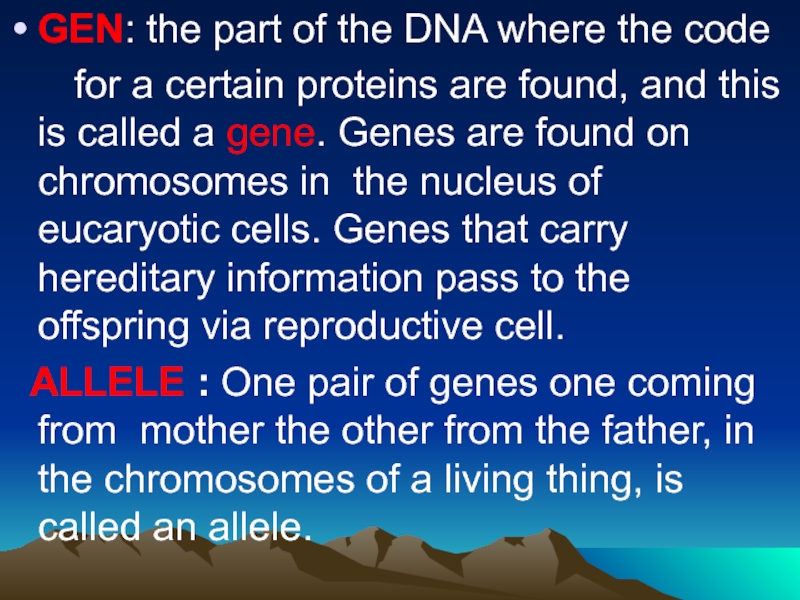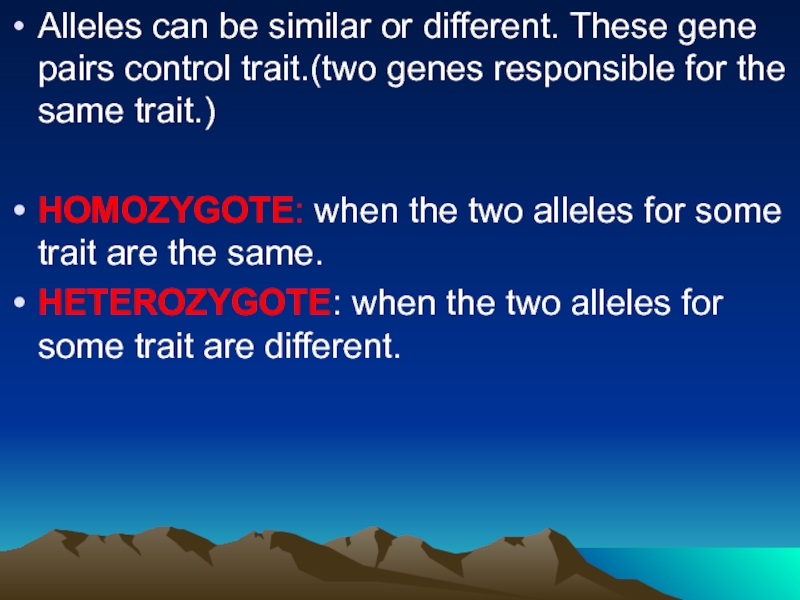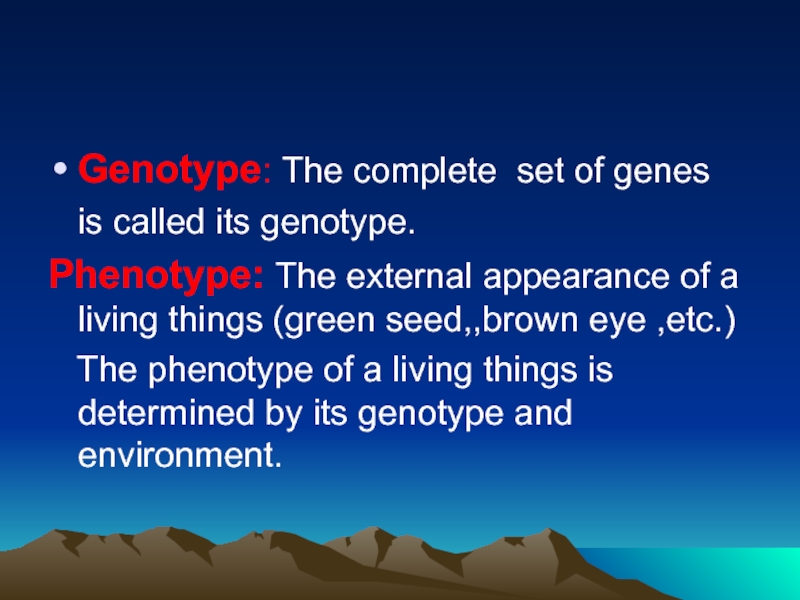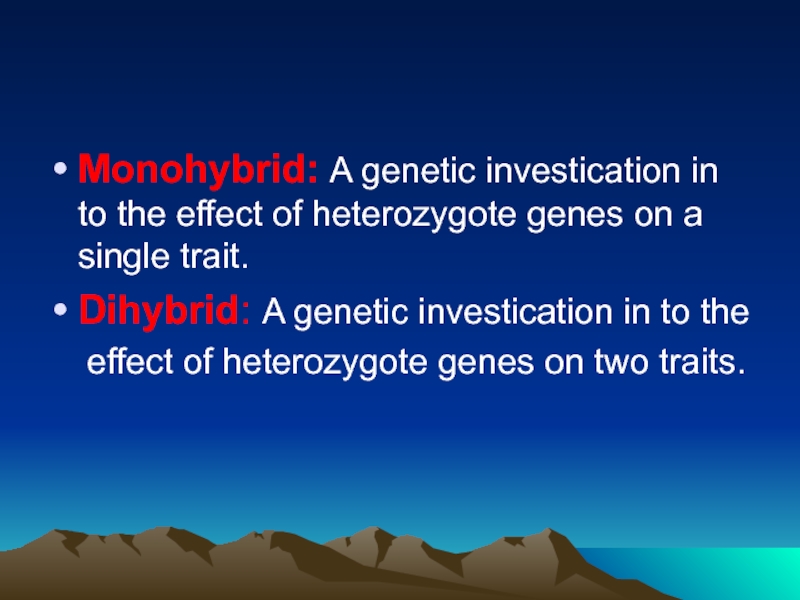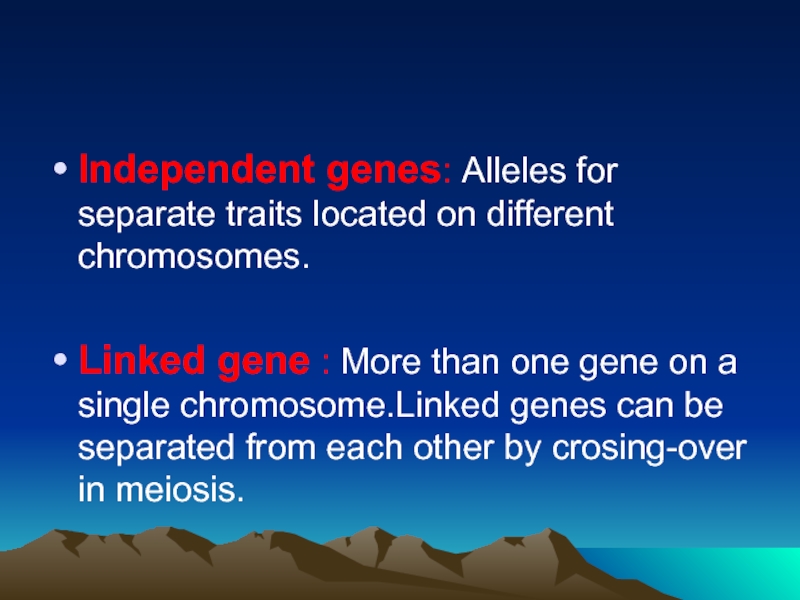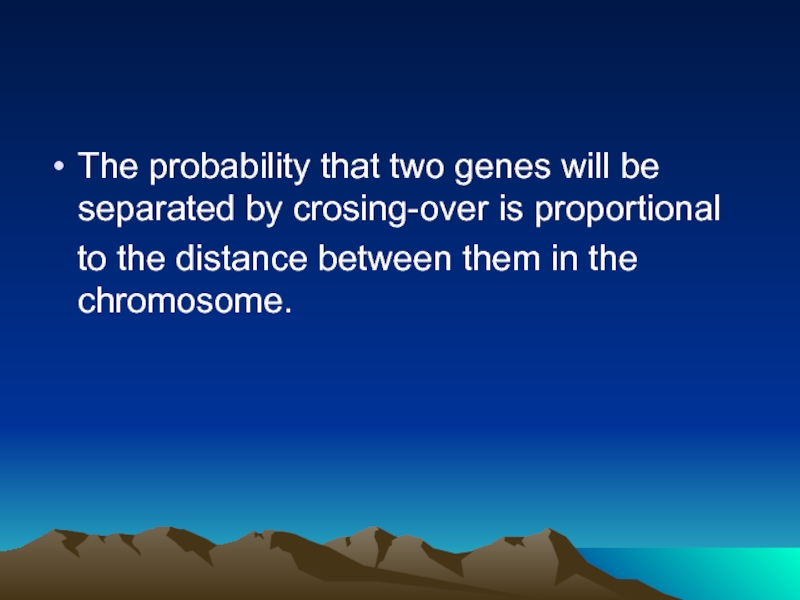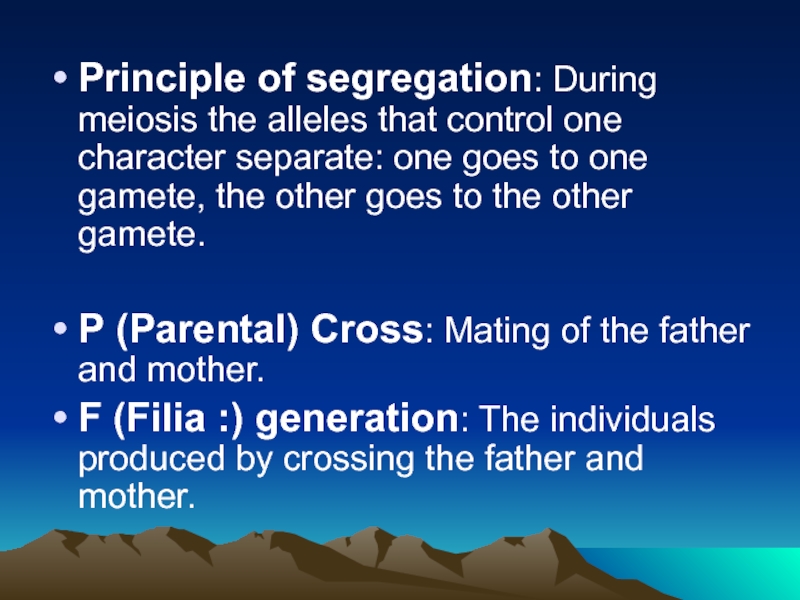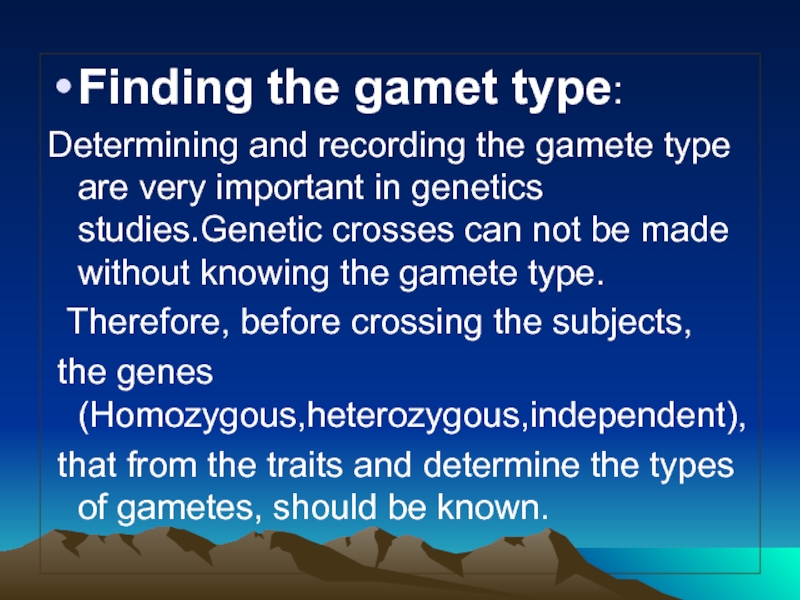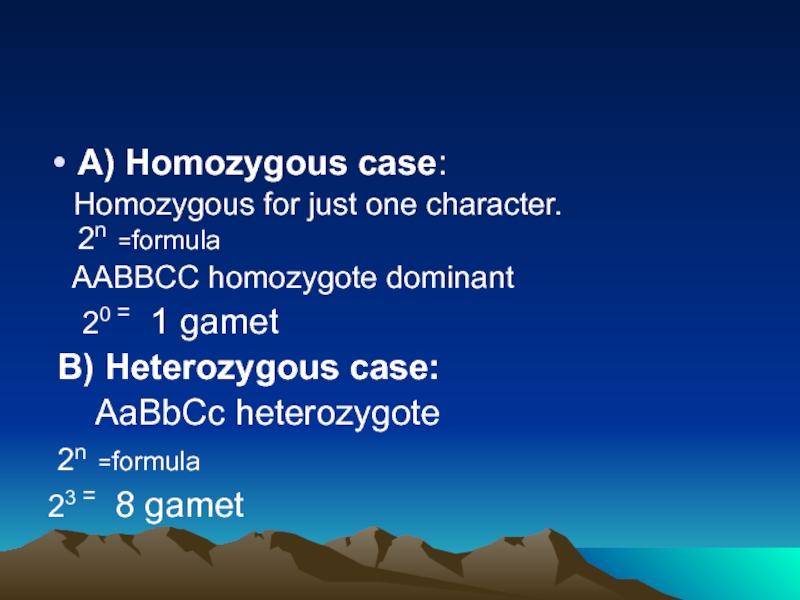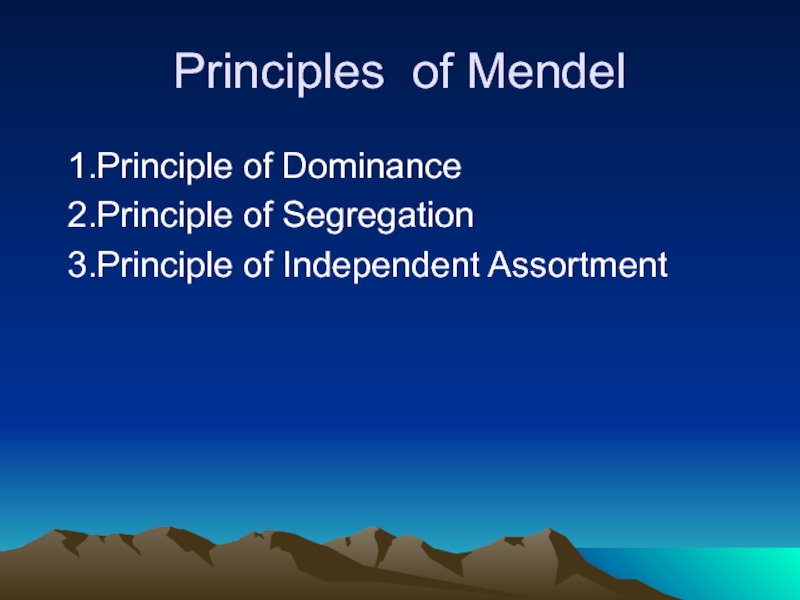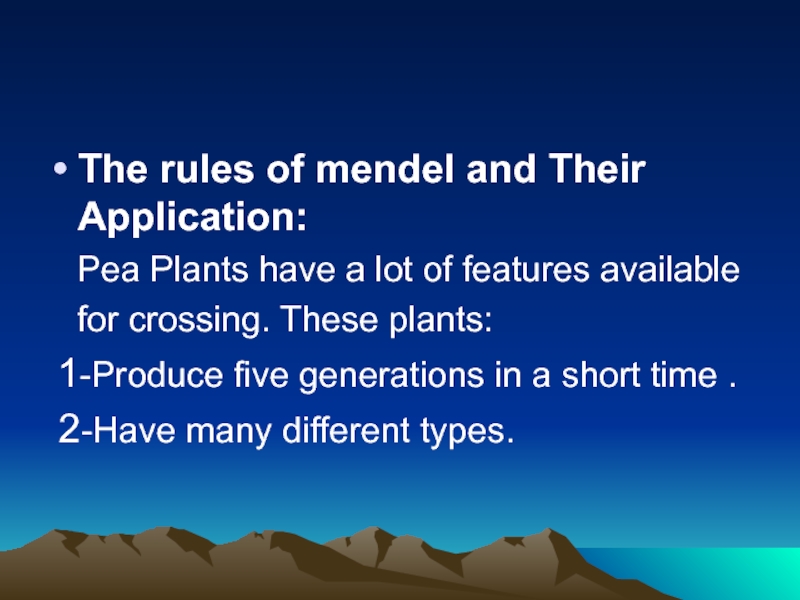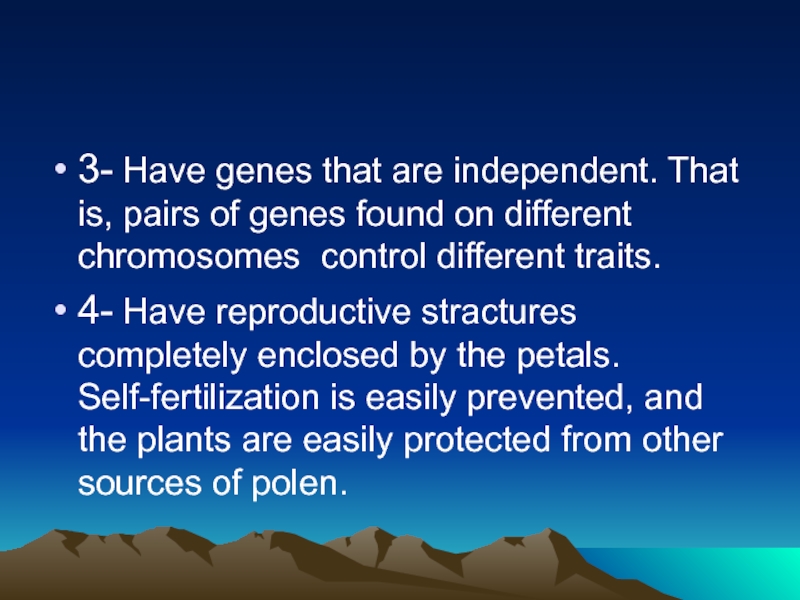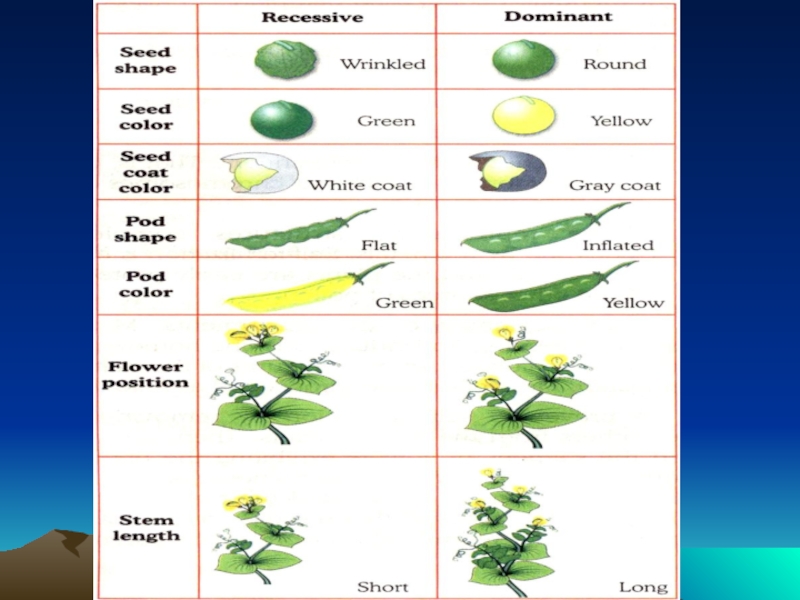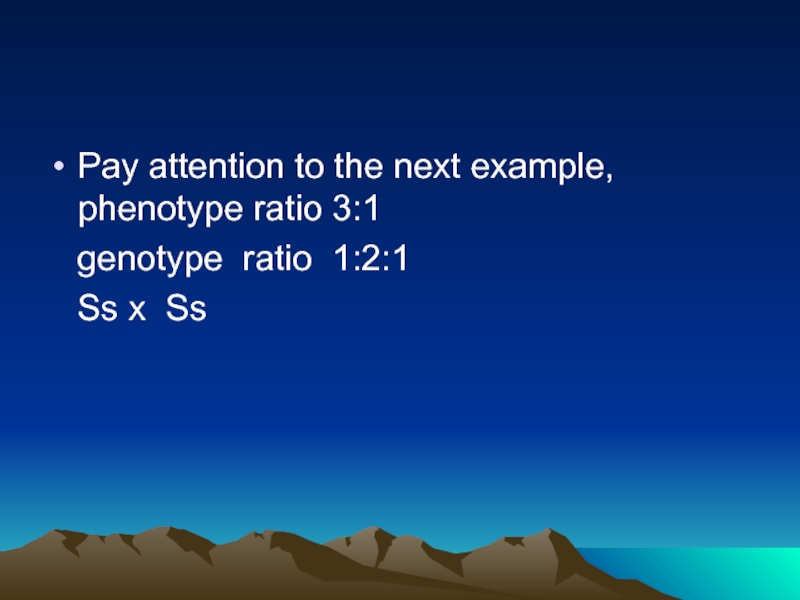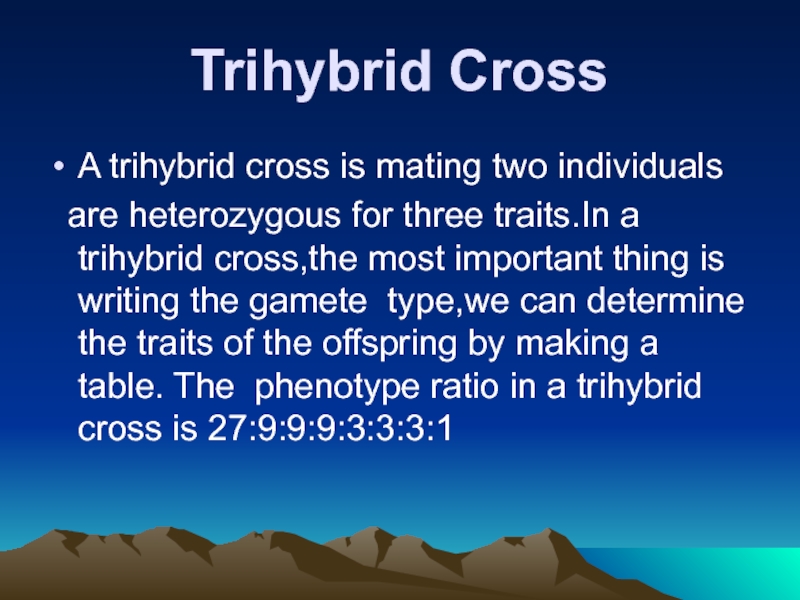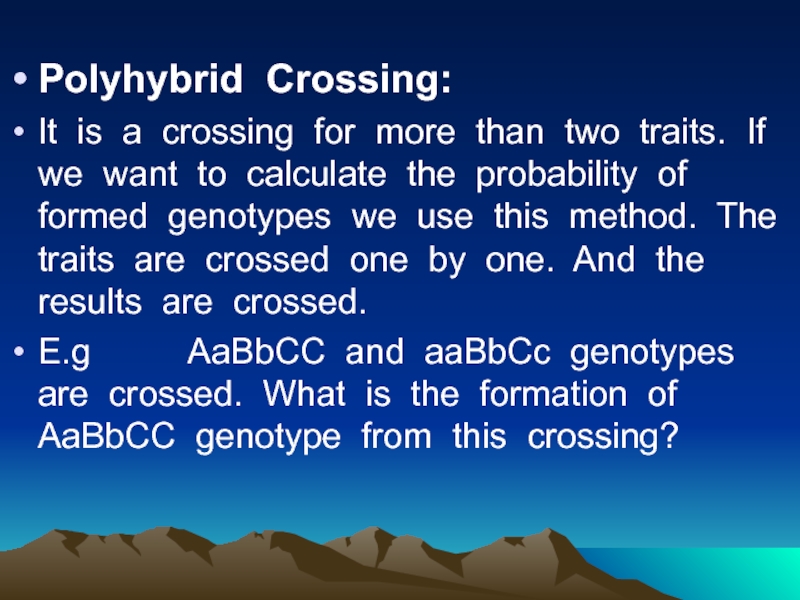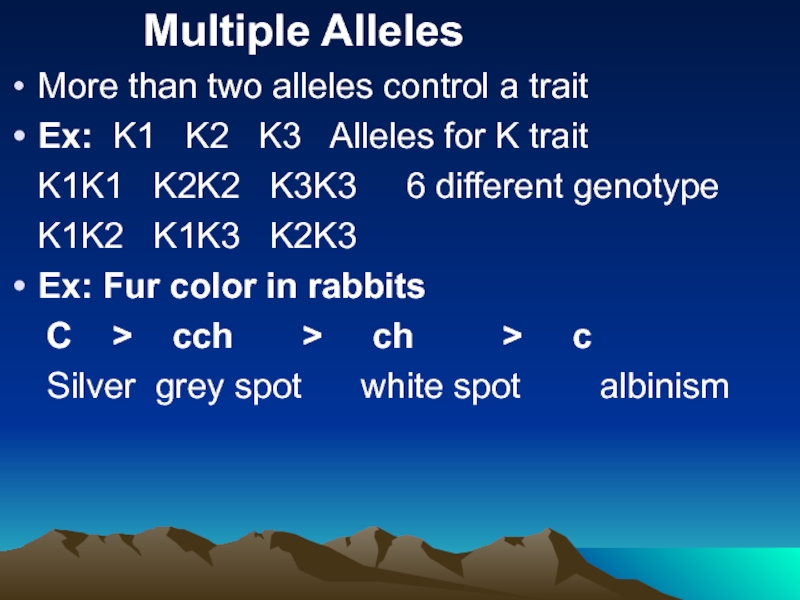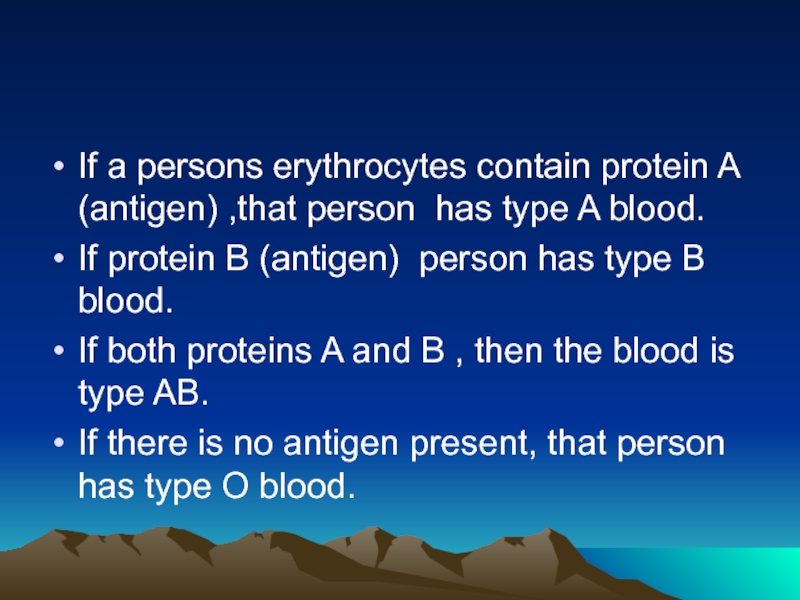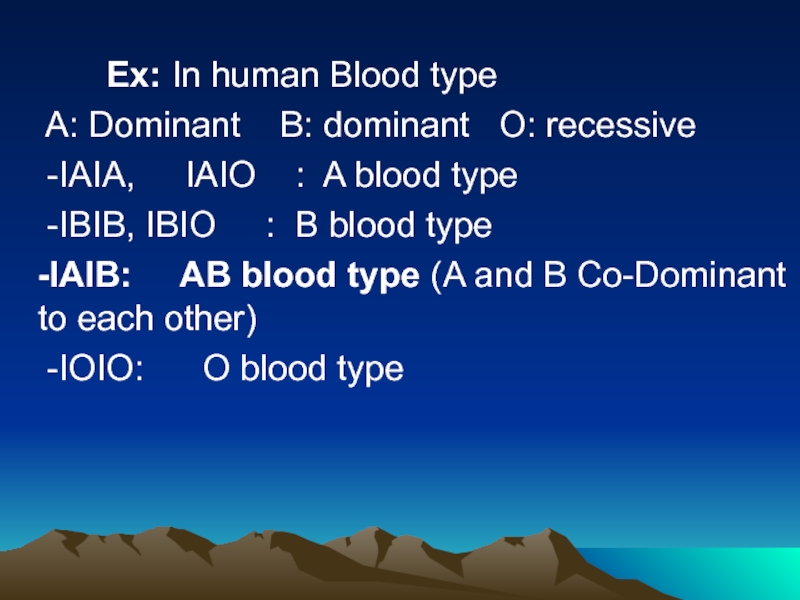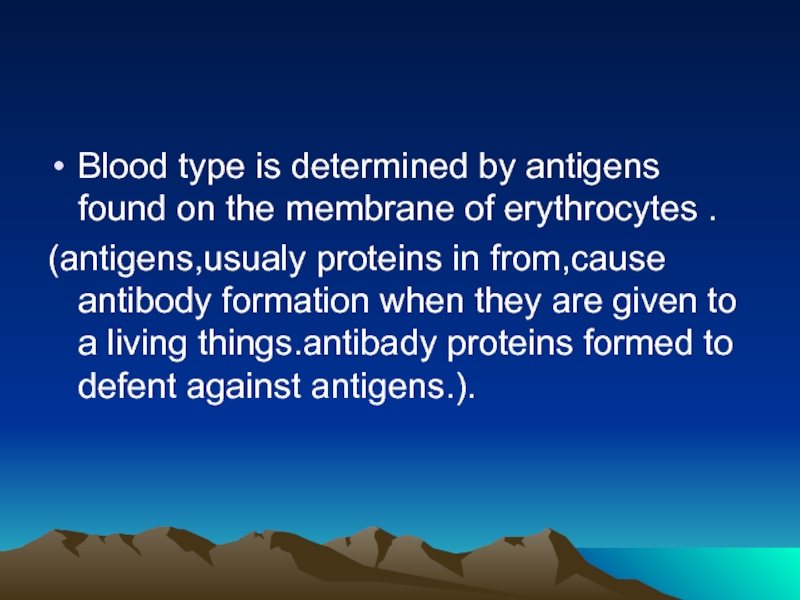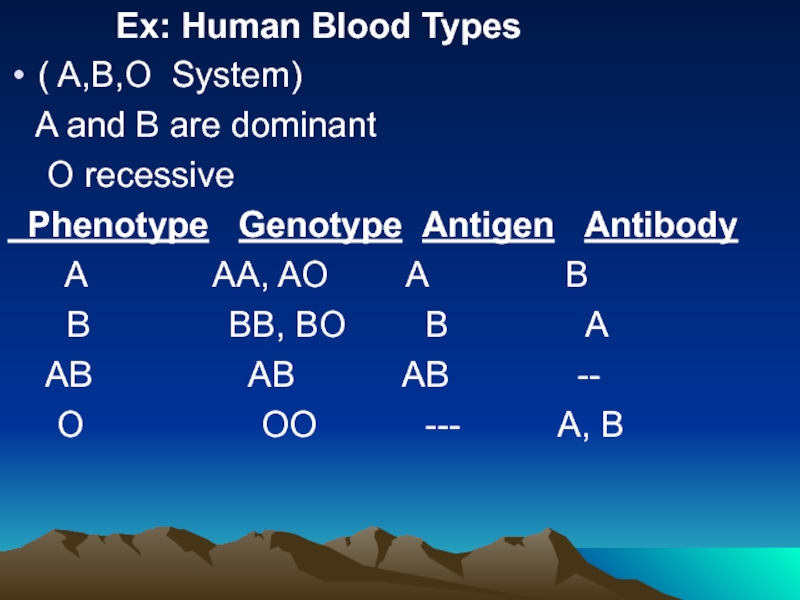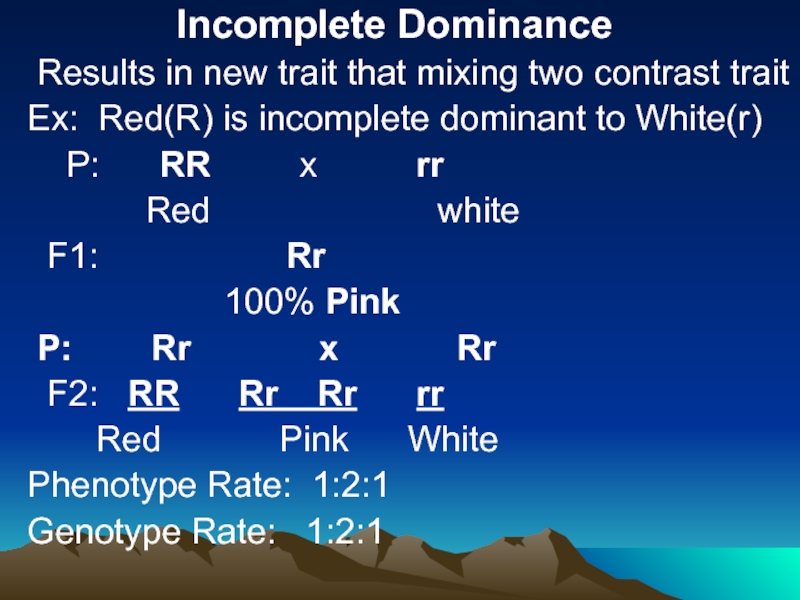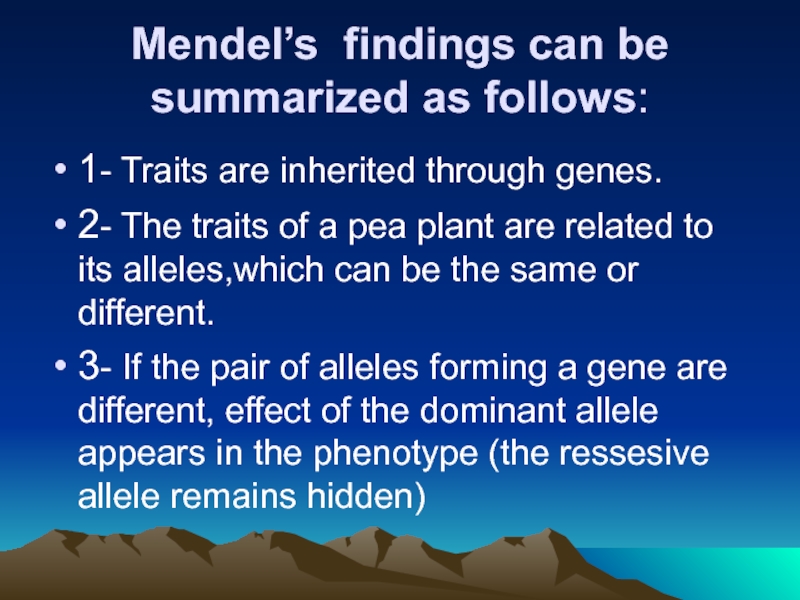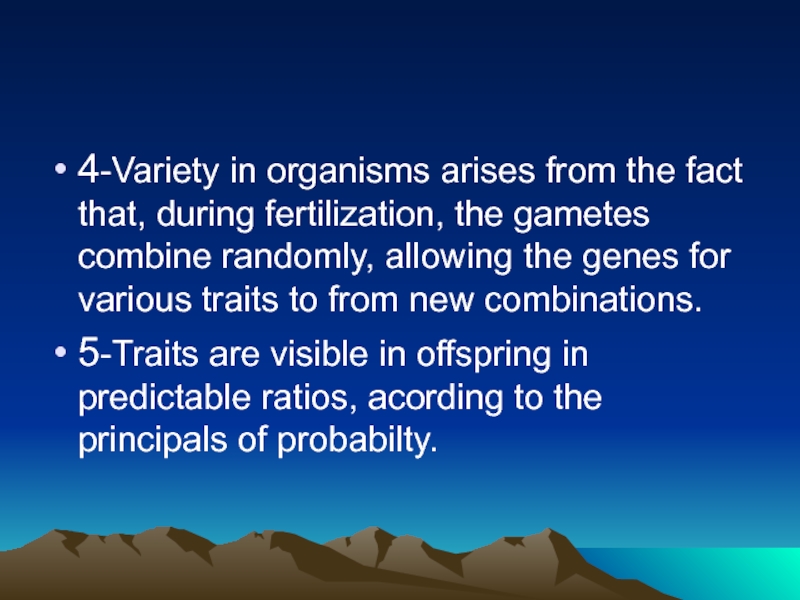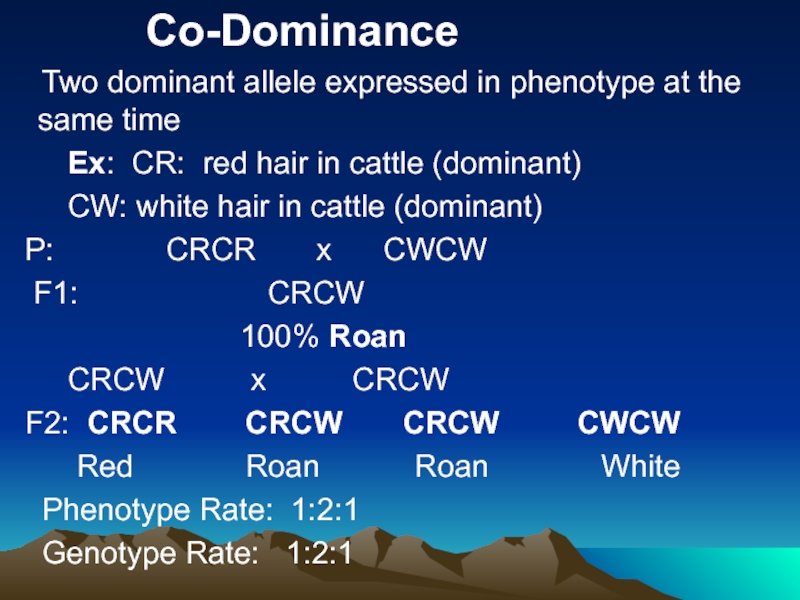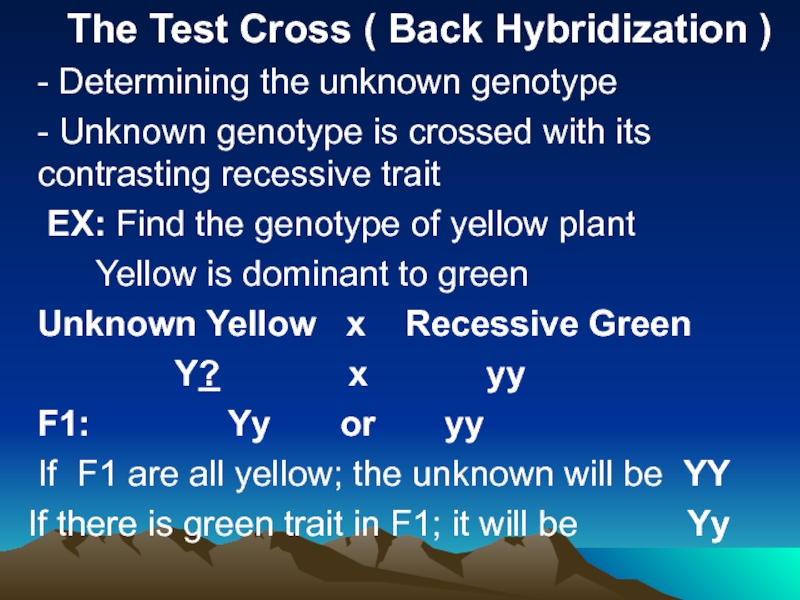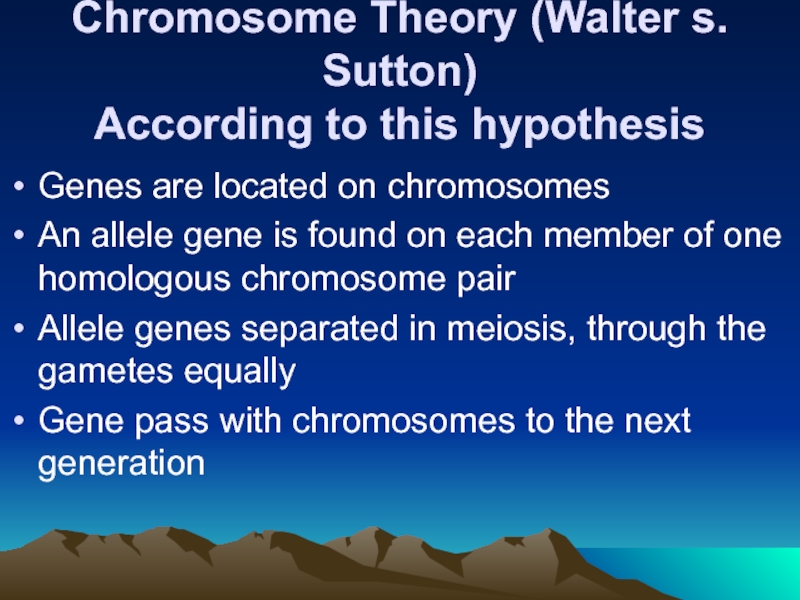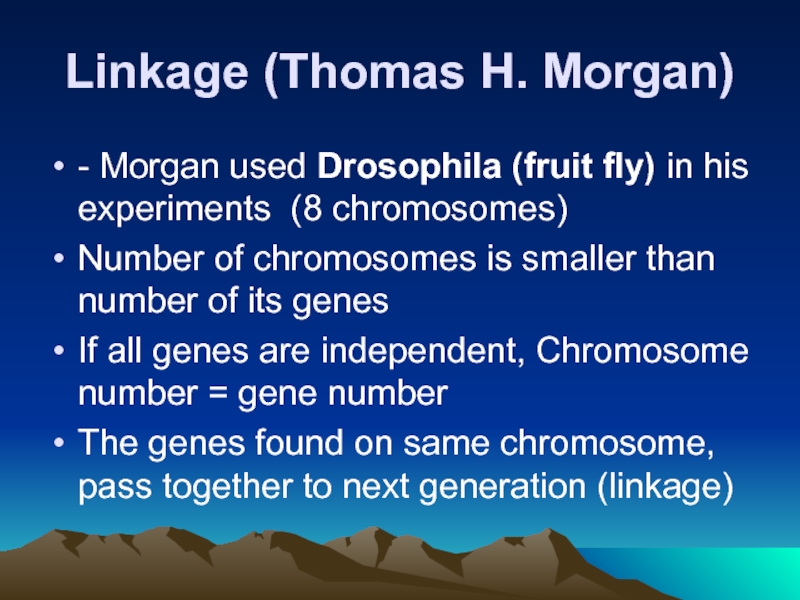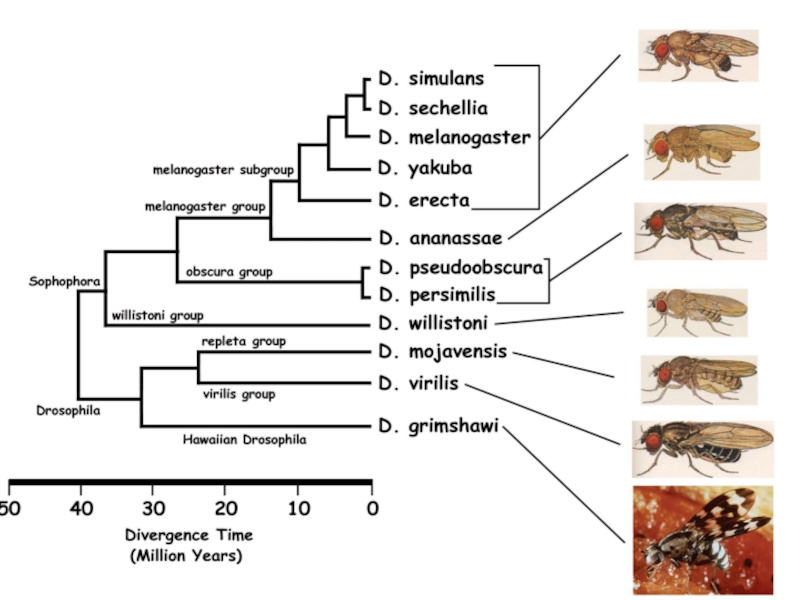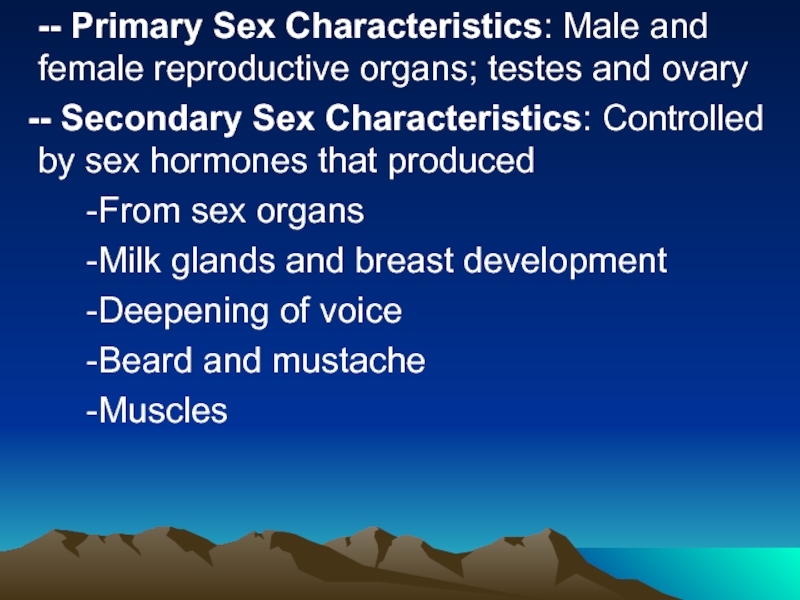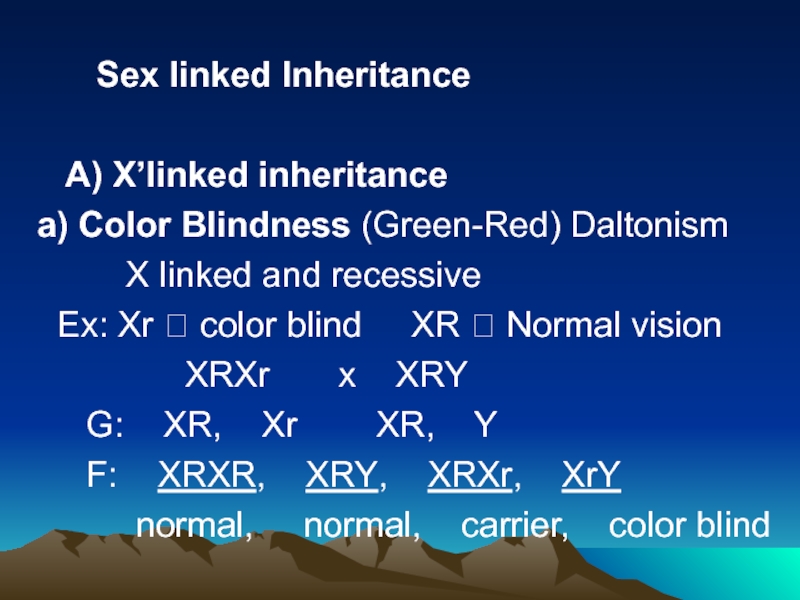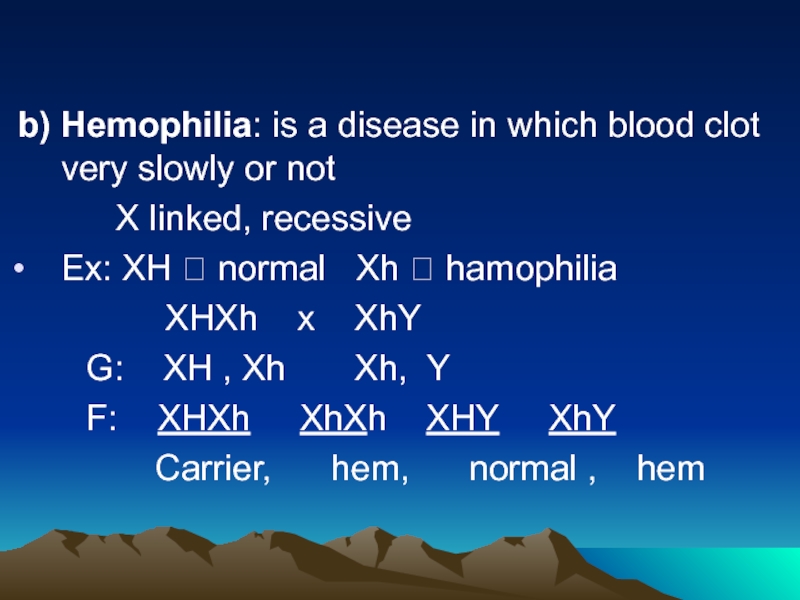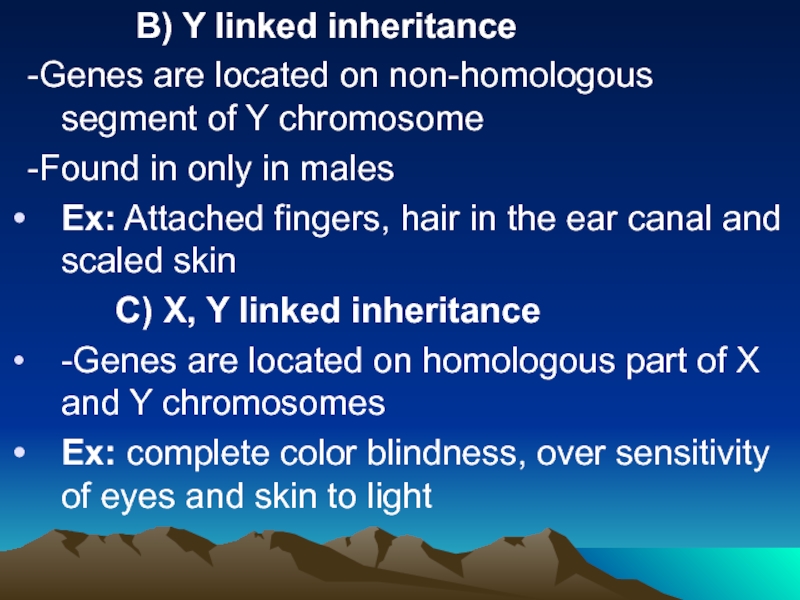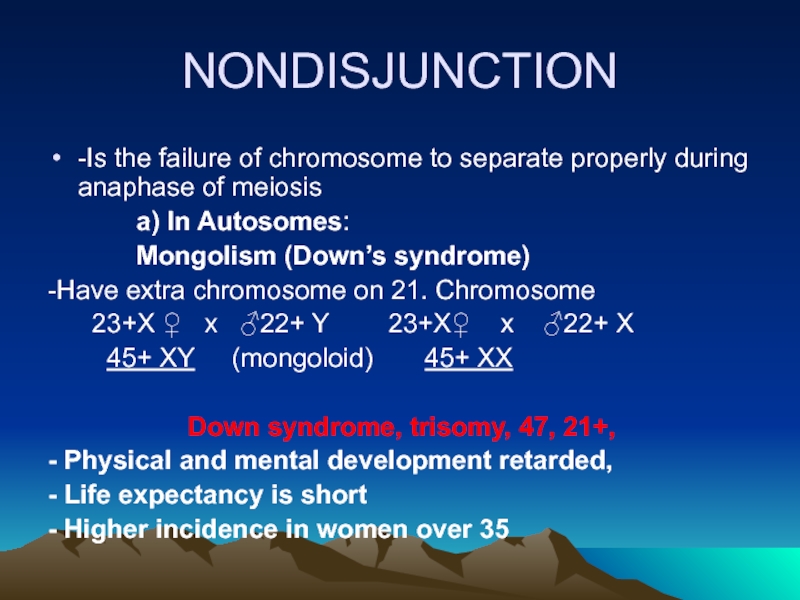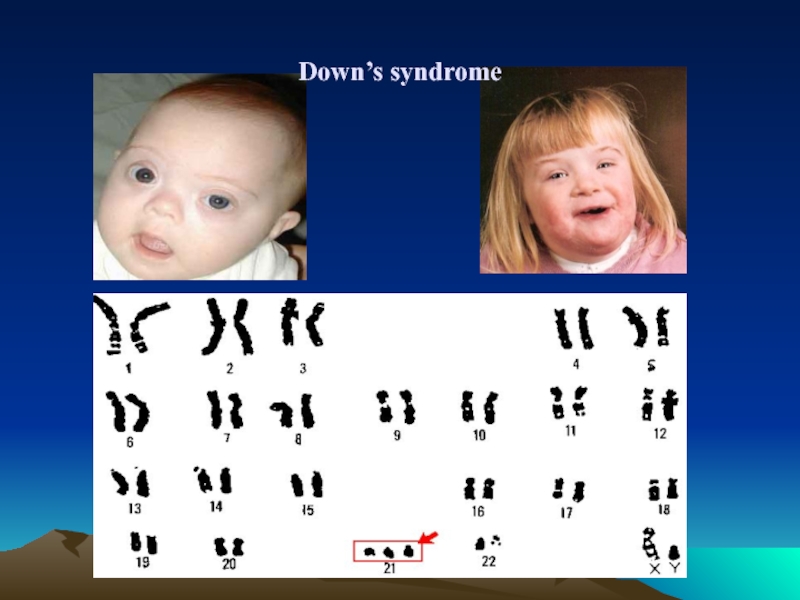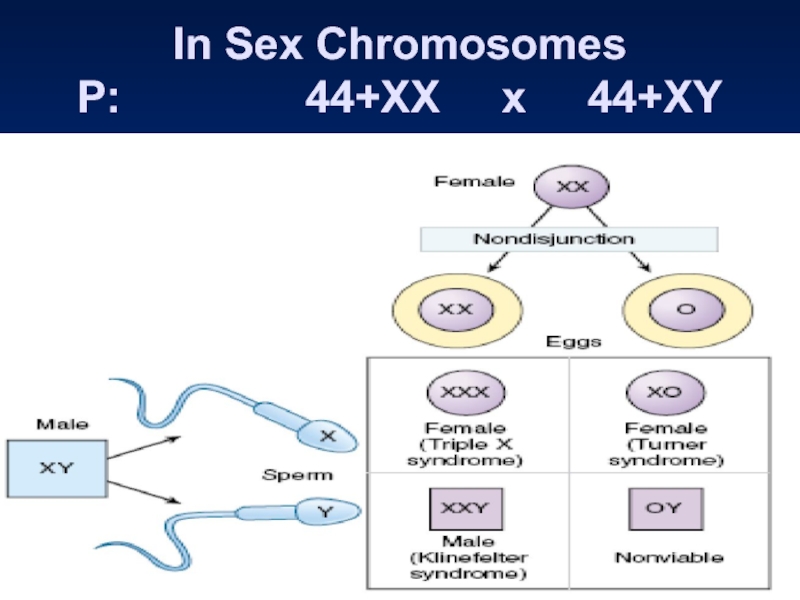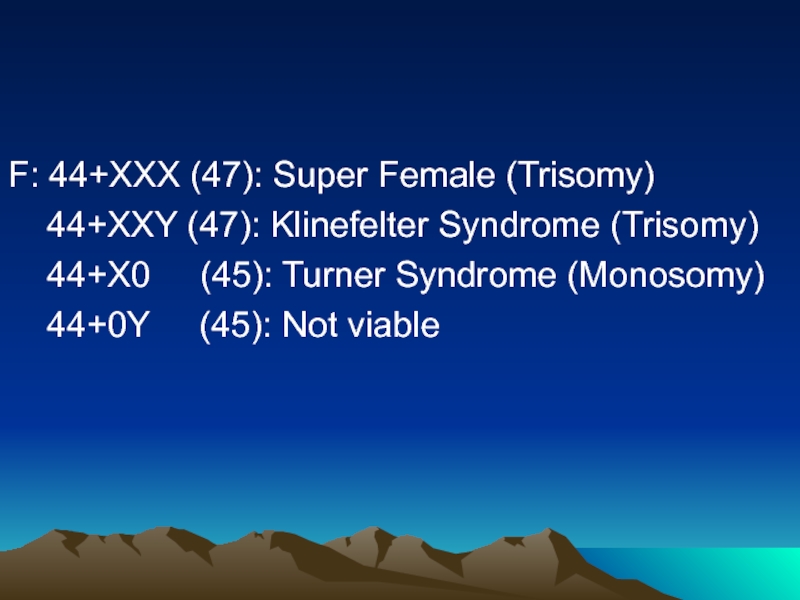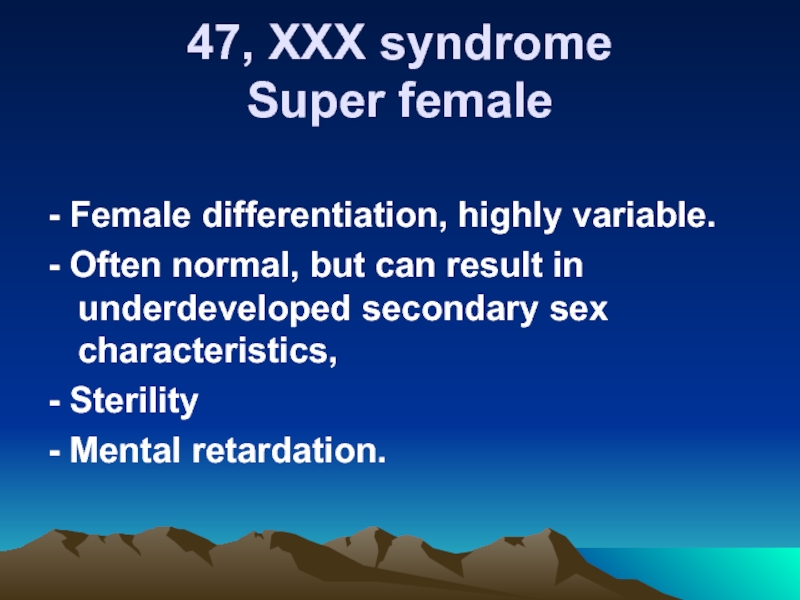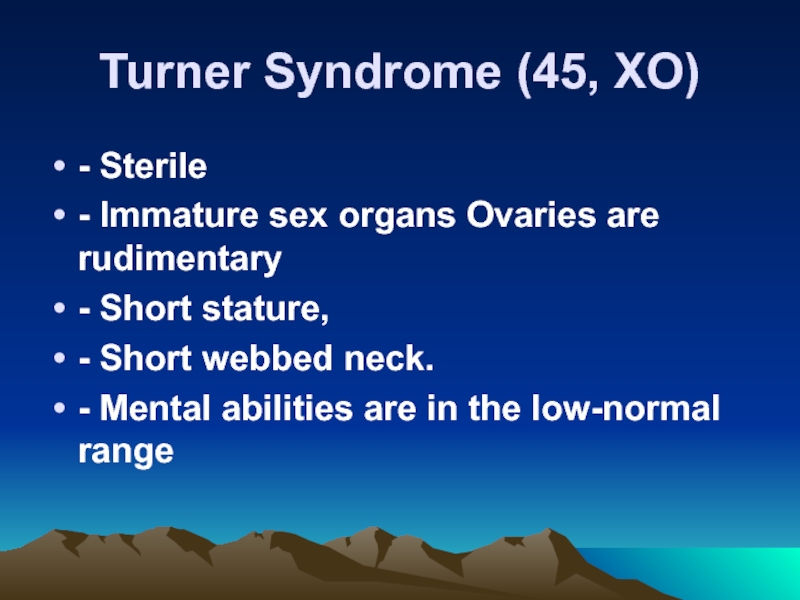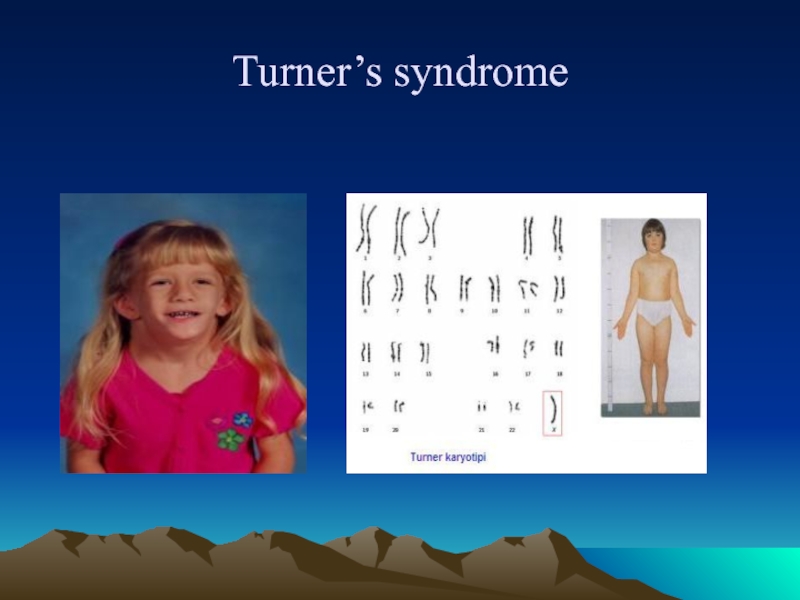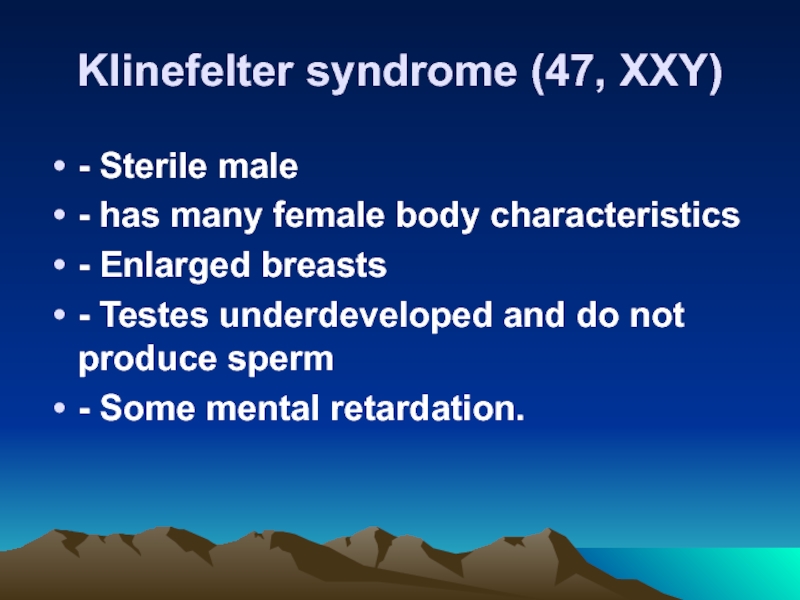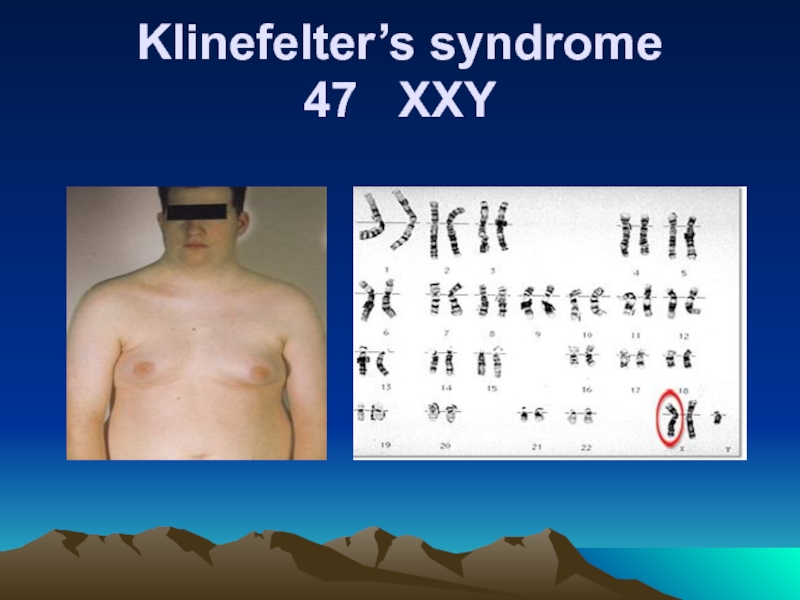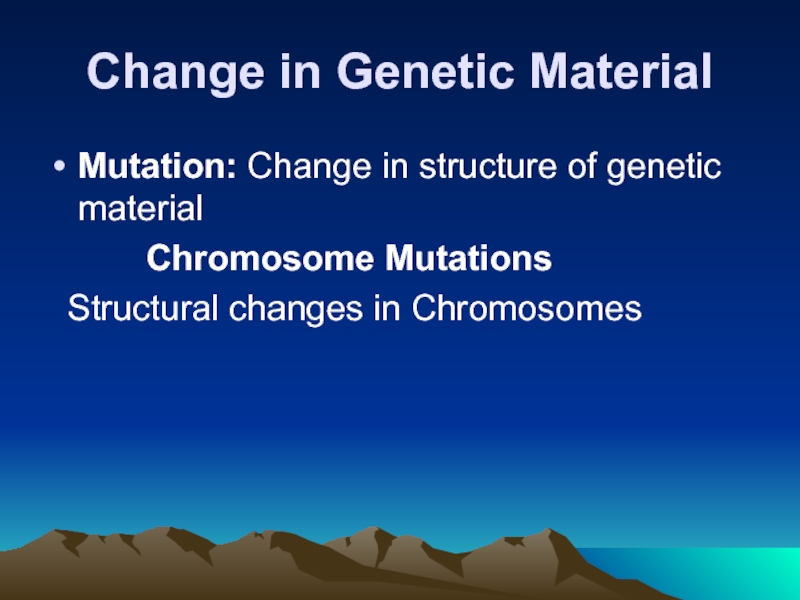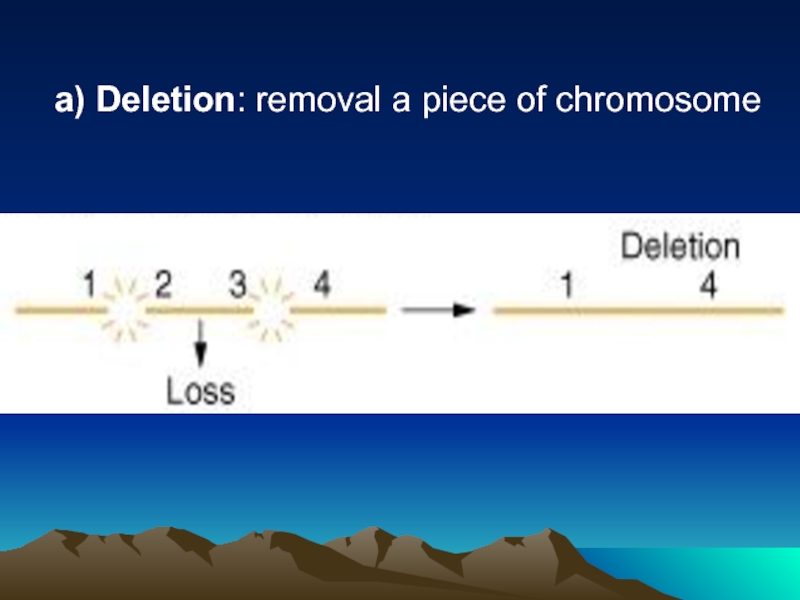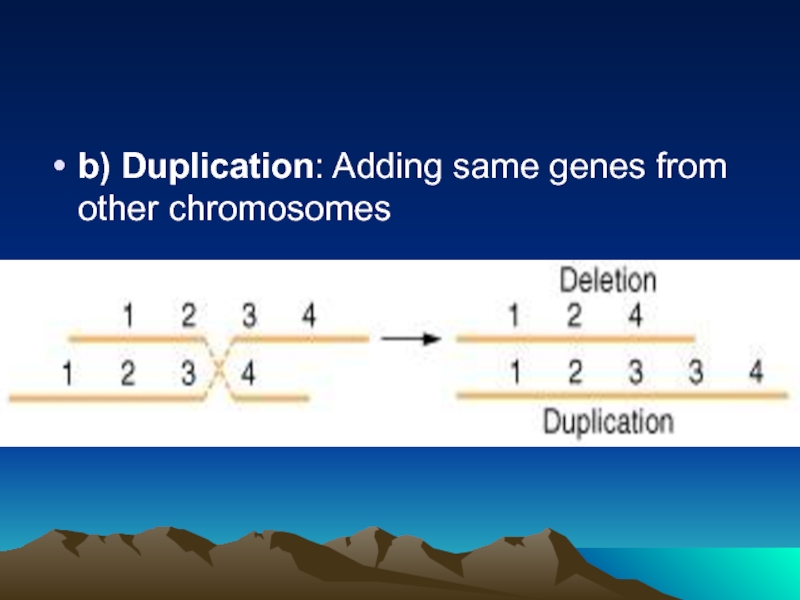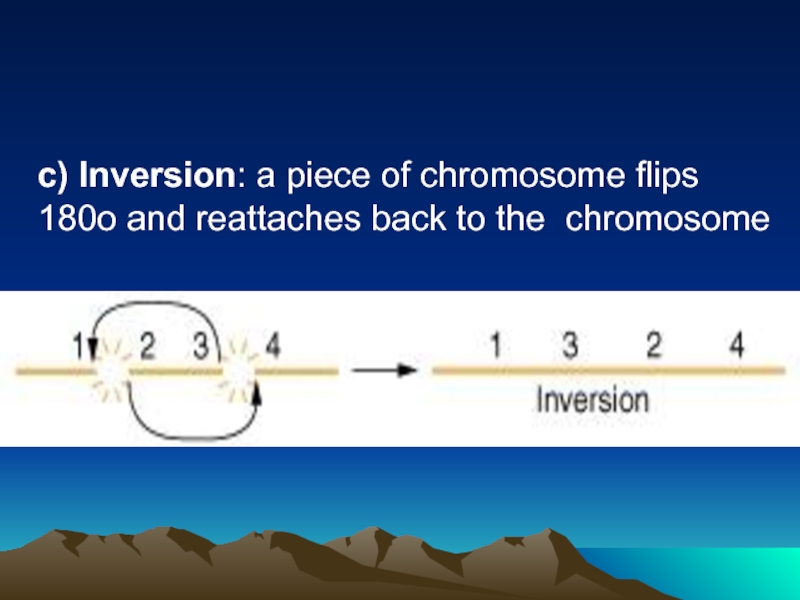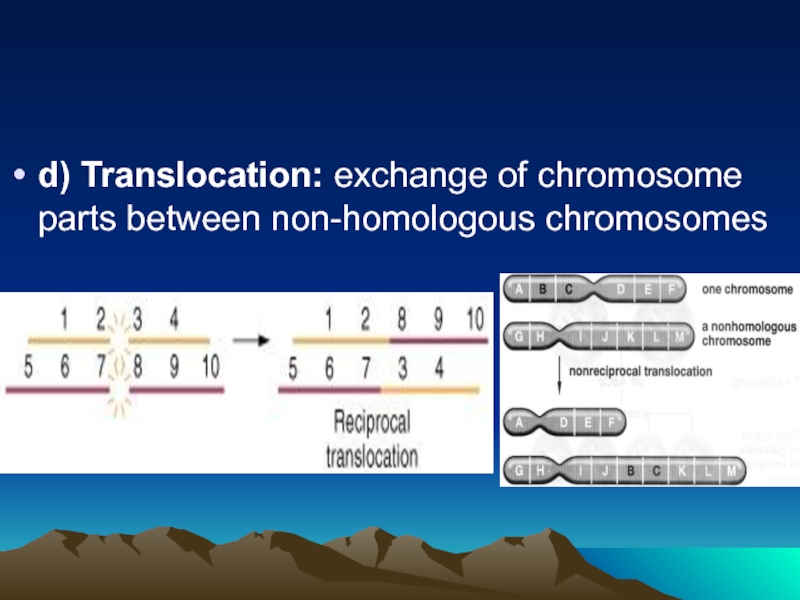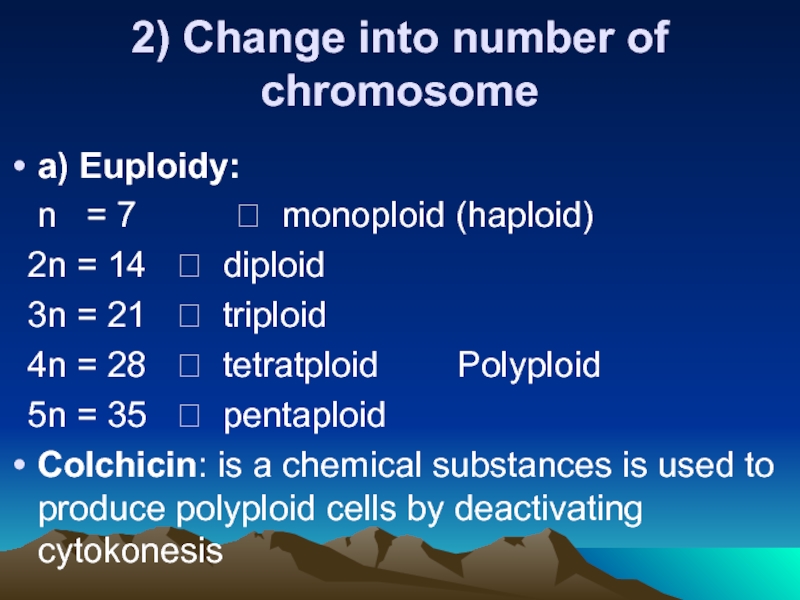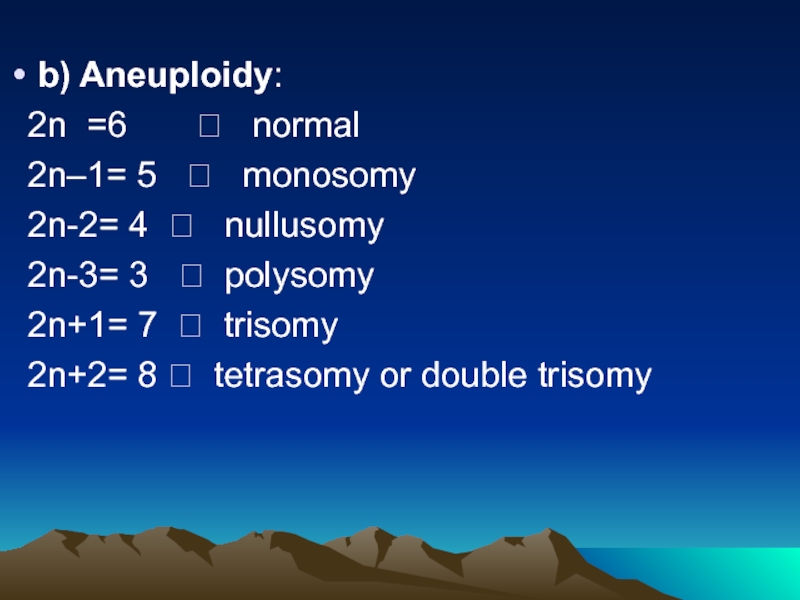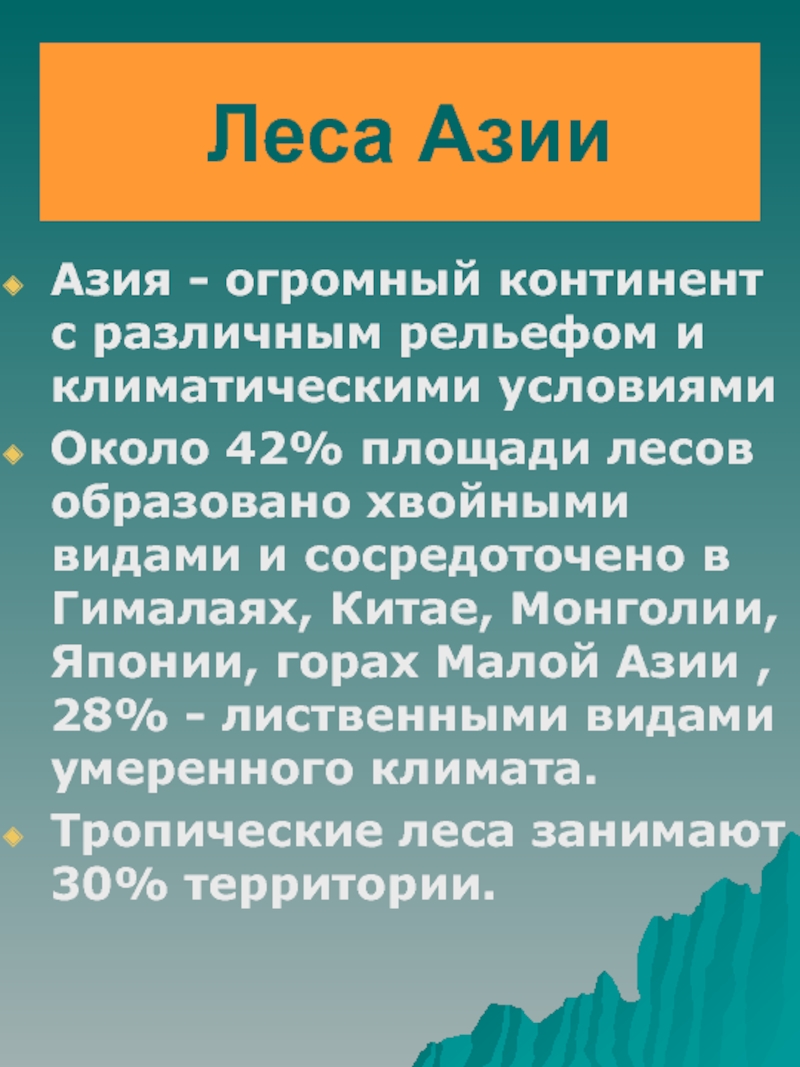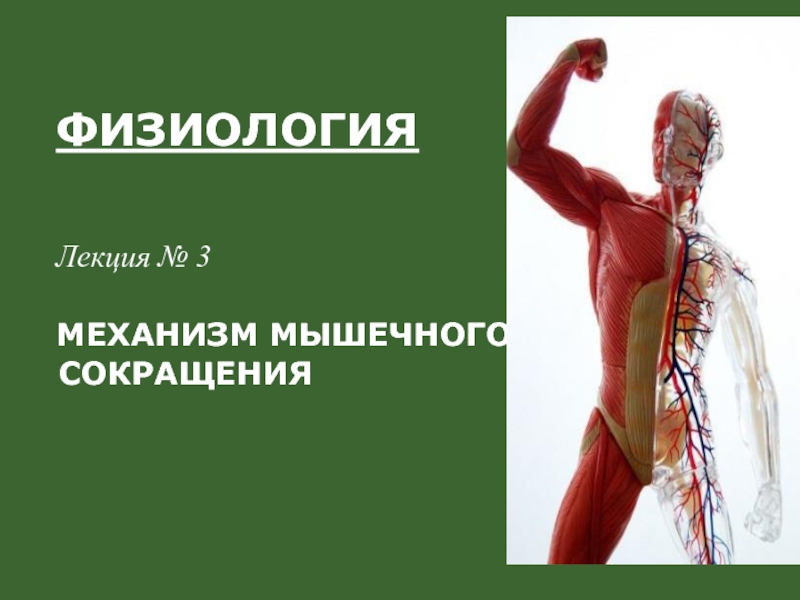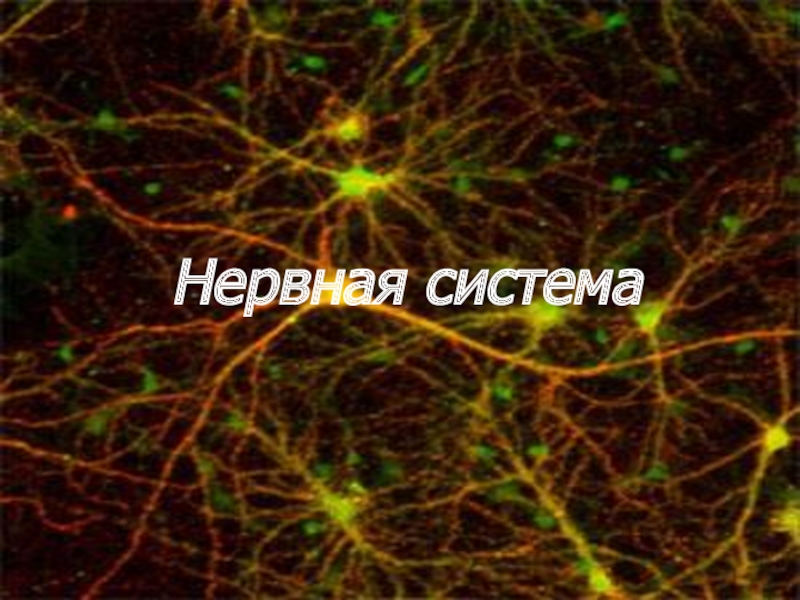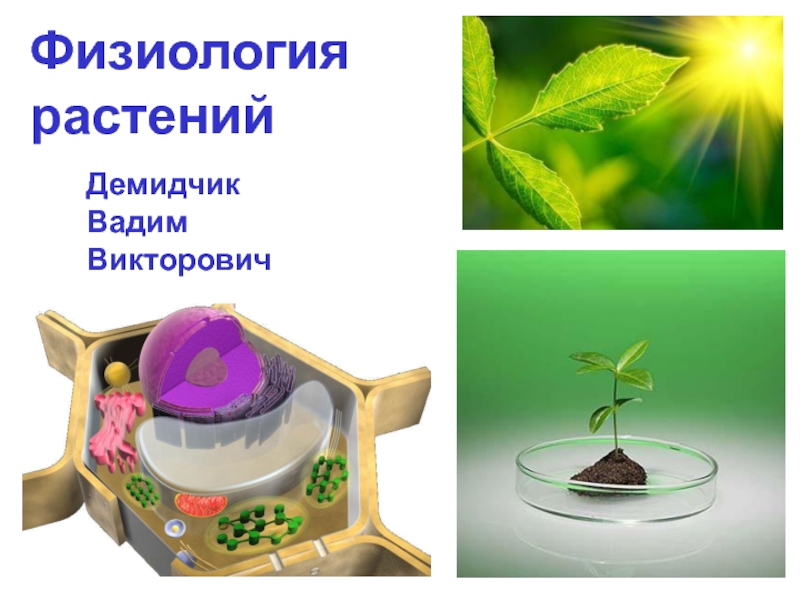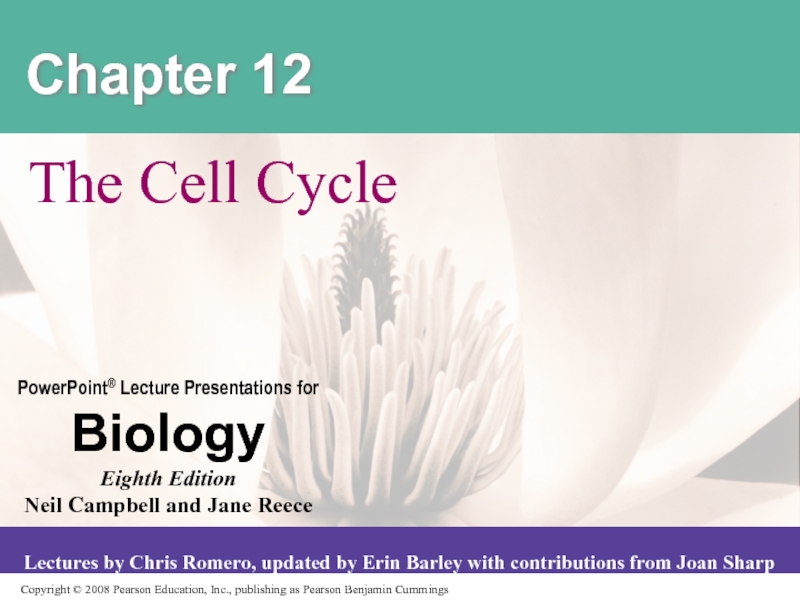- Главная
- Разное
- Дизайн
- Бизнес и предпринимательство
- Аналитика
- Образование
- Развлечения
- Красота и здоровье
- Финансы
- Государство
- Путешествия
- Спорт
- Недвижимость
- Армия
- Графика
- Культурология
- Еда и кулинария
- Лингвистика
- Английский язык
- Астрономия
- Алгебра
- Биология
- География
- Детские презентации
- Информатика
- История
- Литература
- Маркетинг
- Математика
- Медицина
- Менеджмент
- Музыка
- МХК
- Немецкий язык
- ОБЖ
- Обществознание
- Окружающий мир
- Педагогика
- Русский язык
- Технология
- Физика
- Философия
- Химия
- Шаблоны, картинки для презентаций
- Экология
- Экономика
- Юриспруденция
Genetics. Genotype презентация
Содержание
- 1. Genetics. Genotype
- 2. GEN: the part of the DNA where
- 3. Alleles can be similar or different. These
- 4. Dominant gen: The presence of
- 5. Genotype: The complete set of genes
- 6. Monohybrid: A genetic investication in to the
- 7. Independent genes: Alleles for separate traits located
- 8. The probability that two genes will be
- 9. Principle of segregation: During meiosis the alleles
- 10. Finding the gamet type: Determining and recording
- 11. A) Homozygous case: Homozygous for
- 12. GEORGE GREGORY MENDEL (1822-1884)
- 13. Principles of Mendel 1.Principle of Dominance
- 14. The rules of mendel and Their Application:
- 15. 3- Have genes that are independent. That
- 19. Monohybrid Cross Mating two individuals with different
- 20. Pay attention to the next example, phenotype
- 21. Dihybrid cross Mating two true breeding individuals
- 22. Trihybrid Cross A trihybrid cross is mating
- 23. Example: K ; Red flower
- 24. KKDDSS X kkddss
- 25. Polyhybrid Crossing: It is a
- 26. Multiple
- 28. If a persons erythrocytes contain protein A
- 30. Blood type is determined by antigens found
- 31. Ex:
- 33. Mendel’s findings can be summarized as follows:
- 34. 4-Variety in organisms arises from the fact
- 36. The Test Cross (
- 37. Chromosome Theory (Walter s. Sutton) According to
- 38. Linkage (Thomas H. Morgan) - Morgan
- 40. Sex-Linked genes A)
- 41. B) Genotypic Sex Determination
- 42. -- Primary Sex Characteristics: Male
- 44. b) Hemophilia: is
- 46. NONDISJUNCTION -Is the failure of chromosome to
- 47. Down’s syndrome
- 48. In Sex Chromosomes P:
- 49. F: 44+XXX (47): Super
- 50. 47, XXX syndrome Super female -
- 51. Turner Syndrome (45, XO) - Sterile -
- 52. Turner’s syndrome
- 53. Klinefelter syndrome (47, XXY) - Sterile
- 54. Klinefelter’s syndrome 47 XXY
- 55. Change in Genetic Material Mutation: Change in
- 56. a) Deletion: removal a piece of chromosome
- 57. b) Duplication: Adding same genes from other chromosomes
- 58. c) Inversion:
- 59. d) Translocation: exchange of chromosome parts between non-homologous chromosomes
- 60. 2) Change into number of chromosome
- 61. b) Aneuploidy: 2n =6
- 62. mutagens: are the factors that cause the
Слайд 2GEN: the part of the DNA where the code
for a certain proteins are found, and this is called a gene. Genes are found on chromosomes in the nucleus of eucaryotic cells. Genes that carry hereditary information pass to the offspring via reproductive cell.
ALLELE : One pair of genes one coming from mother the other from the father, in the chromosomes of a living thing, is called an allele.
ALLELE : One pair of genes one coming from mother the other from the father, in the chromosomes of a living thing, is called an allele.
Слайд 3Alleles can be similar or different. These gene pairs control trait.(two
genes responsible for the same trait.)
HOMOZYGOTE: when the two alleles for some trait are the same.
HETEROZYGOTE: when the two alleles for some trait are different.
HOMOZYGOTE: when the two alleles for some trait are the same.
HETEROZYGOTE: when the two alleles for some trait are different.
Слайд 4Dominant gen:
The presence of this gene
is
always expressed in the phenotype.
Recessive gen:
The presence of this gene is
expressed only in the homozygote.
Recessive gen:
The presence of this gene is
expressed only in the homozygote.
Слайд 5Genotype: The complete set of genes
is called its
genotype.
Phenotype: The external appearance of a living things (green seed,,brown eye ,etc.)
The phenotype of a living things is determined by its genotype and environment.
Phenotype: The external appearance of a living things (green seed,,brown eye ,etc.)
The phenotype of a living things is determined by its genotype and environment.
Слайд 6Monohybrid: A genetic investication in to the effect of heterozygote genes
on a single trait.
Dihybrid: A genetic investication in to the
effect of heterozygote genes on two traits.
Dihybrid: A genetic investication in to the
effect of heterozygote genes on two traits.
Слайд 7Independent genes: Alleles for separate traits located on different chromosomes.
Linked gene
: More than one gene on a single chromosome.Linked genes can be separated from each other by crosing-over in meiosis.
Слайд 8The probability that two genes will be separated by crosing-over is
proportional
to the distance between them in the chromosome.
to the distance between them in the chromosome.
Слайд 9Principle of segregation: During meiosis the alleles that control one character
separate: one goes to one gamete, the other goes to the other gamete.
P (Parental) Cross: Mating of the father and mother.
F (Filia :) generation: The individuals produced by crossing the father and mother.
P (Parental) Cross: Mating of the father and mother.
F (Filia :) generation: The individuals produced by crossing the father and mother.
Слайд 10Finding the gamet type:
Determining and recording the gamete type are very
important in genetics studies.Genetic crosses can not be made without knowing the gamete type.
Therefore, before crossing the subjects,
the genes (Homozygous,heterozygous,independent),
that from the traits and determine the types of gametes, should be known.
Therefore, before crossing the subjects,
the genes (Homozygous,heterozygous,independent),
that from the traits and determine the types of gametes, should be known.
Слайд 11A) Homozygous case:
Homozygous for just one character.
2n =formula
AABBCC homozygote dominant
20 = 1 gamet
B) Heterozygous case:
AaBbCc heterozygote
2n =formula
23 = 8 gamet
AABBCC homozygote dominant
20 = 1 gamet
B) Heterozygous case:
AaBbCc heterozygote
2n =formula
23 = 8 gamet
Слайд 12
GEORGE GREGORY MENDEL
(1822-1884)
He was the Austrian monk that study genetic
first time.
He use in experiments pea plant.
He use in experiments pea plant.
Слайд 13Principles of Mendel
1.Principle of Dominance
2.Principle of Segregation
3.Principle of
Independent Assortment
Слайд 14The rules of mendel and Their Application:
Pea Plants have
a lot of features available
for crossing. These plants:
1-Produce five generations in a short time .
2-Have many different types.
for crossing. These plants:
1-Produce five generations in a short time .
2-Have many different types.
Слайд 153- Have genes that are independent. That is, pairs of genes
found on different chromosomes control different traits.
4- Have reproductive stractures completely enclosed by the petals. Self-fertilization is easily prevented, and the plants are easily protected from other sources of polen.
4- Have reproductive stractures completely enclosed by the petals. Self-fertilization is easily prevented, and the plants are easily protected from other sources of polen.
Слайд 19Monohybrid Cross
Mating two individuals with different expressions of one trait is
called a monohybrid cross.
For example let’s make a cross between homozygous dominant, yellow-seeded pea plants and homozygous recesive,green-seeded pea plants, and let’s try to find the
F1 offsipring.
For example let’s make a cross between homozygous dominant, yellow-seeded pea plants and homozygous recesive,green-seeded pea plants, and let’s try to find the
F1 offsipring.
Слайд 21Dihybrid cross
Mating two true breeding individuals which
are different
from each other in two traits is called as dihybrid cross.
In a dihybrid cross, the phenotype ratio at F2 is 9:3:3:1 (this ratio was 3:1 in monohybrid cross). Example: SsDd X SsDd
In a dihybrid cross, the phenotype ratio at F2 is 9:3:3:1 (this ratio was 3:1 in monohybrid cross). Example: SsDd X SsDd
Слайд 22Trihybrid Cross
A trihybrid cross is mating two individuals
are heterozygous
for three traits.In a trihybrid cross,the most important thing is writing the gamete type,we can determine the traits of the offspring by making a table. The phenotype ratio in a trihybrid cross is 27:9:9:9:3:3:3:1
Слайд 23Example:
K ; Red flower
k: White flower
D : Round seed d : Wrinkled seed
S : Yellow seed s : Green seed
Homozygote dominant Homozygote resesive
Red flower White flower
Round-Yellow Wrinkled-Green
D : Round seed d : Wrinkled seed
S : Yellow seed s : Green seed
Homozygote dominant Homozygote resesive
Red flower White flower
Round-Yellow Wrinkled-Green
Слайд 25
Polyhybrid Crossing:
It is a crossing for more than two traits.
If we want to calculate the probability of formed genotypes we use this method. The traits are crossed one by one. And the results are crossed.
E.g AaBbCC and aaBbCc genotypes are crossed. What is the formation of AaBbCC genotype from this crossing?
E.g AaBbCC and aaBbCc genotypes are crossed. What is the formation of AaBbCC genotype from this crossing?
Слайд 26 Multiple Alleles
More than two alleles
control a trait
Ex: K1 K2 K3 Alleles for K trait
K1K1 K2K2 K3K3 6 different genotype
K1K2 K1K3 K2K3
Ex: Fur color in rabbits
C > cch > ch > c
Silver grey spot white spot albinism
Ex: K1 K2 K3 Alleles for K trait
K1K1 K2K2 K3K3 6 different genotype
K1K2 K1K3 K2K3
Ex: Fur color in rabbits
C > cch > ch > c
Silver grey spot white spot albinism
Слайд 27
HUMAN BLOOD TYPES
In 1904 Landsteiner discovered there are four blood types. There are A,B,AB,O Erythrocytes from one person are mixed with the serum from another person,either the erythrocytes scatter in the serum homogeneously or gather together in clumps (agglutinotion),after which they repture (hemolysis).
In 1904 Landsteiner discovered there are four blood types. There are A,B,AB,O Erythrocytes from one person are mixed with the serum from another person,either the erythrocytes scatter in the serum homogeneously or gather together in clumps (agglutinotion),after which they repture (hemolysis).
Слайд 28If a persons erythrocytes contain protein A (antigen) ,that person has
type A blood.
If protein B (antigen) person has type B blood.
If both proteins A and B , then the blood is type AB.
If there is no antigen present, that person has type O blood.
If protein B (antigen) person has type B blood.
If both proteins A and B , then the blood is type AB.
If there is no antigen present, that person has type O blood.
Слайд 29
Ex: In human Blood
type
A: Dominant B: dominant O: recessive
-IAIA, IAIO : A blood type
-IBIB, IBIO : B blood type
-IAIB: AB blood type (A and B Co-Dominant to each other)
-IOIO: O blood type
A: Dominant B: dominant O: recessive
-IAIA, IAIO : A blood type
-IBIB, IBIO : B blood type
-IAIB: AB blood type (A and B Co-Dominant to each other)
-IOIO: O blood type
Слайд 30Blood type is determined by antigens found on the membrane of
erythrocytes .
(antigens,usualy proteins in from,cause antibody formation when they are given to a living things.antibady proteins formed to defent against antigens.).
(antigens,usualy proteins in from,cause antibody formation when they are given to a living things.antibady proteins formed to defent against antigens.).
Слайд 31 Ex: Human Blood Types
( A,B,O
System)
A and B are dominant
O recessive
Phenotype Genotype Antigen Antibody
A AA, AO A B
B BB, BO B A
AB AB AB --
O OO --- A, B
A and B are dominant
O recessive
Phenotype Genotype Antigen Antibody
A AA, AO A B
B BB, BO B A
AB AB AB --
O OO --- A, B
Слайд 32 Incomplete Dominance
Results in new trait that mixing two contrast trait
Ex: Red(R) is incomplete dominant to White(r)
P: RR x rr
Red white
F1: Rr
100% Pink
P: Rr x Rr
F2: RR Rr Rr rr
Red Pink White
Phenotype Rate: 1:2:1
Genotype Rate: 1:2:1
Ex: Red(R) is incomplete dominant to White(r)
P: RR x rr
Red white
F1: Rr
100% Pink
P: Rr x Rr
F2: RR Rr Rr rr
Red Pink White
Phenotype Rate: 1:2:1
Genotype Rate: 1:2:1
Слайд 33Mendel’s findings can be summarized as follows:
1- Traits are inherited through
genes.
2- The traits of a pea plant are related to its alleles,which can be the same or different.
3- If the pair of alleles forming a gene are different, effect of the dominant allele appears in the phenotype (the ressesive allele remains hidden)
2- The traits of a pea plant are related to its alleles,which can be the same or different.
3- If the pair of alleles forming a gene are different, effect of the dominant allele appears in the phenotype (the ressesive allele remains hidden)
Слайд 344-Variety in organisms arises from the fact that, during fertilization, the
gametes combine randomly, allowing the genes for various traits to from new combinations.
5-Traits are visible in offspring in predictable ratios, acording to the principals of probabilty.
5-Traits are visible in offspring in predictable ratios, acording to the principals of probabilty.
Слайд 35 Co-Dominance
Two
dominant allele expressed in phenotype at the same time
Ex: CR: red hair in cattle (dominant)
CW: white hair in cattle (dominant)
P: CRCR x CWCW
F1: CRCW
100% Roan
CRCW x CRCW
F2: CRCR CRCW CRCW CWCW
Red Roan Roan White
Phenotype Rate: 1:2:1
Genotype Rate: 1:2:1
Ex: CR: red hair in cattle (dominant)
CW: white hair in cattle (dominant)
P: CRCR x CWCW
F1: CRCW
100% Roan
CRCW x CRCW
F2: CRCR CRCW CRCW CWCW
Red Roan Roan White
Phenotype Rate: 1:2:1
Genotype Rate: 1:2:1
Слайд 36 The Test Cross ( Back Hybridization )
- Determining the unknown genotype
- Unknown genotype is crossed with its contrasting recessive trait
EX: Find the genotype of yellow plant
Yellow is dominant to green
Unknown Yellow x Recessive Green
Y? x yy
F1: Yy or yy
If F1 are all yellow; the unknown will be YY
If there is green trait in F1; it will be Yy
- Unknown genotype is crossed with its contrasting recessive trait
EX: Find the genotype of yellow plant
Yellow is dominant to green
Unknown Yellow x Recessive Green
Y? x yy
F1: Yy or yy
If F1 are all yellow; the unknown will be YY
If there is green trait in F1; it will be Yy
Слайд 37Chromosome Theory (Walter s. Sutton)
According to this hypothesis
Genes are located on
chromosomes
An allele gene is found on each member of one homologous chromosome pair
Allele genes separated in meiosis, through the gametes equally
Gene pass with chromosomes to the next generation
An allele gene is found on each member of one homologous chromosome pair
Allele genes separated in meiosis, through the gametes equally
Gene pass with chromosomes to the next generation
Слайд 38Linkage (Thomas H. Morgan)
- Morgan used Drosophila (fruit fly) in
his experiments (8 chromosomes)
Number of chromosomes is smaller than number of its genes
If all genes are independent, Chromosome number = gene number
The genes found on same chromosome, pass together to next generation (linkage)
Number of chromosomes is smaller than number of its genes
If all genes are independent, Chromosome number = gene number
The genes found on same chromosome, pass together to next generation (linkage)
Слайд 40Sex-Linked genes
A) Phenotypic Sex Determination:
Environmental
factors determine sex of an
organism
Growing area
Nutrition
Temperature
Day length
organism
Growing area
Nutrition
Temperature
Day length
Слайд 41 B) Genotypic Sex Determination : Sex chromosomes determine
the sex of an organism
a) XX-XY Mechanism: human, drosophilia
XX: female♀ XY: male♂
b) ZZ-ZW Mechanism: butterfly, reptiles, some fish, Birds
ZZ: male♂ ZW: female♀
c) XX-XO Mechanism: insects
XX: female♀ XO: male♂
d) Haploid-Diploid Mechanism: honey bee, wasp
Haploid (n): male ♂ Diploid (2n): female♀
a) XX-XY Mechanism: human, drosophilia
XX: female♀ XY: male♂
b) ZZ-ZW Mechanism: butterfly, reptiles, some fish, Birds
ZZ: male♂ ZW: female♀
c) XX-XO Mechanism: insects
XX: female♀ XO: male♂
d) Haploid-Diploid Mechanism: honey bee, wasp
Haploid (n): male ♂ Diploid (2n): female♀
Слайд 42 -- Primary Sex Characteristics: Male and female reproductive organs;
testes and ovary
-- Secondary Sex Characteristics: Controlled by sex hormones that produced
-From sex organs
-Milk glands and breast development
-Deepening of voice
-Beard and mustache
-Muscles
-- Secondary Sex Characteristics: Controlled by sex hormones that produced
-From sex organs
-Milk glands and breast development
-Deepening of voice
-Beard and mustache
-Muscles
Слайд 43
Sex linked Inheritance
A) X’linked inheritance
a) Color Blindness (Green-Red) Daltonism
X linked and recessive
Ex: Xr ? color blind XR ? Normal vision
XRXr x XRY
G: XR, Xr XR, Y
F: XRXR, XRY, XRXr, XrY
normal, normal, carrier, color blind
A) X’linked inheritance
a) Color Blindness (Green-Red) Daltonism
X linked and recessive
Ex: Xr ? color blind XR ? Normal vision
XRXr x XRY
G: XR, Xr XR, Y
F: XRXR, XRY, XRXr, XrY
normal, normal, carrier, color blind
Слайд 44
b) Hemophilia: is a disease in which blood clot
very slowly or not
X linked, recessive
Ex: XH ? normal Xh ? hamophilia
XHXh x XhY
G: XH , Xh Xh, Y
F: XHXh XhXh XHY XhY
Carrier, hem, normal , hem
X linked, recessive
Ex: XH ? normal Xh ? hamophilia
XHXh x XhY
G: XH , Xh Xh, Y
F: XHXh XhXh XHY XhY
Carrier, hem, normal , hem
Слайд 45 B) Y linked inheritance
-Genes are located on non-homologous segment of Y chromosome
-Found in only in males
Ex: Attached fingers, hair in the ear canal and scaled skin
C) X, Y linked inheritance
-Genes are located on homologous part of X and Y chromosomes
Ex: complete color blindness, over sensitivity of eyes and skin to light
-Found in only in males
Ex: Attached fingers, hair in the ear canal and scaled skin
C) X, Y linked inheritance
-Genes are located on homologous part of X and Y chromosomes
Ex: complete color blindness, over sensitivity of eyes and skin to light
Слайд 46NONDISJUNCTION
-Is the failure of chromosome to separate properly during anaphase of
meiosis
a) In Autosomes:
Mongolism (Down’s syndrome)
-Have extra chromosome on 21. Chromosome
23+X ♀ x ♂22+ Y 23+X♀ x ♂22+ X
45+ XY (mongoloid) 45+ XX
Down syndrome, trisomy, 47, 21+,
- Physical and mental development retarded,
- Life expectancy is short
- Higher incidence in women over 35
a) In Autosomes:
Mongolism (Down’s syndrome)
-Have extra chromosome on 21. Chromosome
23+X ♀ x ♂22+ Y 23+X♀ x ♂22+ X
45+ XY (mongoloid) 45+ XX
Down syndrome, trisomy, 47, 21+,
- Physical and mental development retarded,
- Life expectancy is short
- Higher incidence in women over 35
Слайд 49
F: 44+XXX (47): Super Female (Trisomy)
44+XXY (47): Klinefelter Syndrome
(Trisomy)
44+X0 (45): Turner Syndrome (Monosomy)
44+0Y (45): Not viable
44+X0 (45): Turner Syndrome (Monosomy)
44+0Y (45): Not viable
Слайд 5047, XXX syndrome
Super female
- Female differentiation, highly variable.
- Often normal,
but can result in underdeveloped secondary sex characteristics,
- Sterility
- Mental retardation.
- Sterility
- Mental retardation.
Слайд 51Turner Syndrome (45, XO)
- Sterile
- Immature sex organs Ovaries are rudimentary
-
Short stature,
- Short webbed neck.
- Mental abilities are in the low-normal range
- Short webbed neck.
- Mental abilities are in the low-normal range
Слайд 53Klinefelter syndrome (47, XXY)
- Sterile male
- has many female body
characteristics
- Enlarged breasts
- Testes underdeveloped and do not produce sperm
- Some mental retardation.
- Enlarged breasts
- Testes underdeveloped and do not produce sperm
- Some mental retardation.
Слайд 55Change in Genetic Material
Mutation: Change in structure of genetic material
Chromosome Mutations
Structural changes in Chromosomes
Structural changes in Chromosomes
Слайд 602) Change into number of chromosome
a) Euploidy:
n
= 7 ? monoploid (haploid)
2n = 14 ? diploid
3n = 21 ? triploid
4n = 28 ? tetratploid Polyploid
5n = 35 ? pentaploid
Colchicin: is a chemical substances is used to produce polyploid cells by deactivating cytokonesis
2n = 14 ? diploid
3n = 21 ? triploid
4n = 28 ? tetratploid Polyploid
5n = 35 ? pentaploid
Colchicin: is a chemical substances is used to produce polyploid cells by deactivating cytokonesis
Слайд 61
b) Aneuploidy:
2n =6 ? normal
2n–1= 5 ? monosomy
2n-2= 4 ? nullusomy
2n-3= 3 ? polysomy
2n+1= 7 ? trisomy
2n+2= 8 ? tetrasomy or double trisomy
2n-2= 4 ? nullusomy
2n-3= 3 ? polysomy
2n+1= 7 ? trisomy
2n+2= 8 ? tetrasomy or double trisomy
Слайд 62mutagens: are the factors that cause the mutation
- Temperature
- Radiation with high energy
- Chemical compounds
- pH level
- Chemical compounds
- pH level

